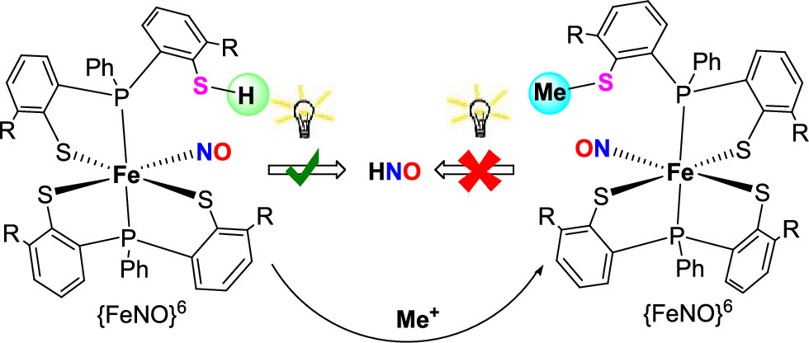Institute of Chemistry, Academia Sinica – Research
以垂掛硫醇之單核鐵觸媒 {FeNO}6 做光催化 NO 與 HNO 產生
Photoinduced NO and HNO Production from Mononuclear {FeNO}6 Complex Bearing a Pendant ThiolJ. Am. Chem. Soc. 2020, 142, 8649−8661. Chuan-Kuei Chiang, Kai-Ti Chu, Chia-Chin Lin, Shi-Rou Xie, Yu-Chiao Liu, Serhiy Demeshko, Gene-Hsiang Lee, Franc Meyer, Ming-Li Tsai,* Ming-Hsi Chiang,* and Chien-Ming Lee*
一氧化氮 (NO) 與次硝酸 (HNO) 在生理學過程中扮演著極重要之角色,NO 與 HNO/NO- 之關鍵受體通常是由含鐵與硫配位基組成且為具生物活性之錯合物。例如,以含 NO 鍵結血質基鐵之水溶性鳥苷酸環化酶(sGC)調控內生性環鳥嘌呤單磷酸核苷(cGMP)生成是神經調節與血管舒張的關鍵步驟。除此之外,HNO 也能引發血管舒張並且比 NO 呈現更好的反應,因此可被視為治療心臟衰竭的潛在強心劑。因為 NO/HNO 在生理系統上與醫藥應用的重要性啟發,許多研究專注在金屬配位的NO或HNO釋放反應物開發上。外生性 Fe-NO 的 NO 釋放可以來自酸鹼度的改變、溶劑效應、熱或光。然而從 Fe-NO(M(HNO/NO-)) 產生之 HNO 反應仍然相對少被研究。在此著作研究中,我們開發了一特殊含硫醇之{FeNO}6 化合物 1,以可見光照射可誘發 NO/HNO 釋放。化合物 1 中的垂掛硫醇之質子與鐵中心形成 [SH•••ON-Fe] 作用可以作為 NO trap,最終在持續的激發之下而產生HNO。反應機制經由泛涵密度理論(DFT)的探究顯示,化合物 1 的可見光吸收為配位基至金屬中心的電子轉移 (LMCT) 與配位基至配位基 (NO) 的電子轉移 (LLCT),因此減弱了 Fe-NO 鍵結。重要的是,在硫醇之質子與 NO 靠近的過程中會發生電子自旋交叉 (Spin crossover),從低自旋 (Low spin) 組態轉變為自由能量較低的高自旋 (High spin) 組態。這些機制探討結論充足的支持了實驗中的觀察現象,化合物 1 在可見光的激發之下生成HNO。實驗與理論的結果顯示了分子內垂掛之質子對 HNO 生成的重要性。
We report two light-sensitive {FeNO}6 complexes, [Fe(NO)(TMSPS2)(TMSPS2H)] (1) with a pendant thiol. Complex 1 simultaneously possesses a NO group and a proton donor, which appears to be a favorable situation for HNO formation. Electronic modulation of the Fe−NO center by light irradiation for complex 1 results in the generation of NO radicals. The substituent in the secondary coordination sphere plays a significant role in dictating the fate of the photo-promoted NO. The pendant thiol of complex 1 situated above the iron-bound NO serves as a NO trap via an intramolecular [SH···ON−Fe] interaction, facilitating the release of HNO. The results reveal the important roles of the photoexcitation and the intramolecular pendant thiol proton in the HNO production. This is also a rare example of the HNO release from an electron-deficient {MNO} core. Further studies to examine the redox chemistry of complex 1 relative to the HNO production are ongoing.

